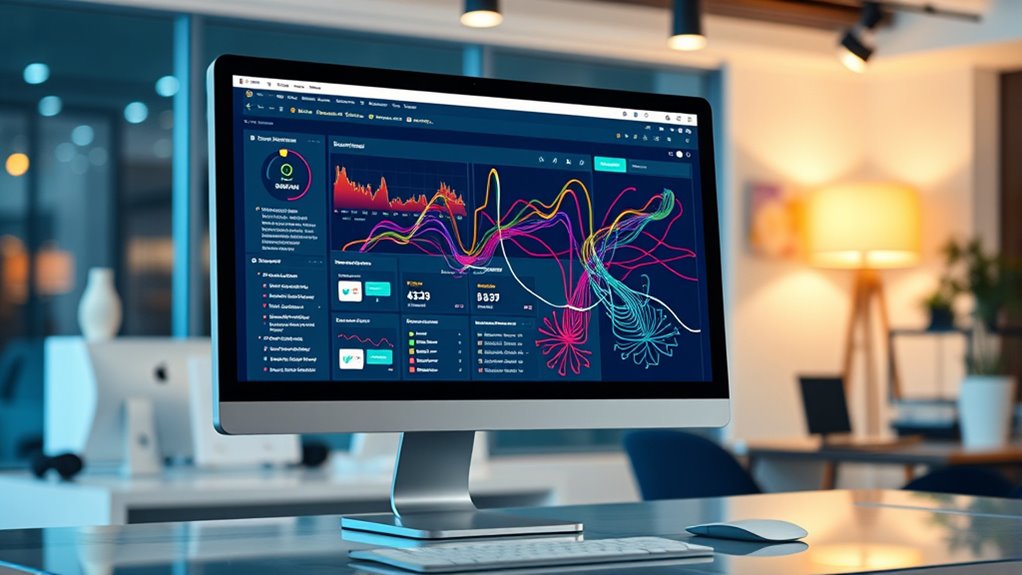To create internal links that feel natural and boost topical clusters, focus on placing links where they make sense contextually and add value for visitors. Use descriptive anchor text that accurately reflects the linked content, avoiding forced or generic phrases. Link to related pages organically within your content, reflecting real-life topic relationships. Regularly check and update your links to keep them relevant. If you want to discover more tips, keep exploring how to seamlessly integrate effective internal linking into your site.
Key Takeaways
- Embed links within content where topics naturally overlap to enhance relevance and user experience.
- Use descriptive, contextually appropriate anchor text that reflects the linked page’s content.
- Focus on creating logical connections between related pages to build strong topical clusters.
- Regularly audit and update internal links to maintain relevance and improve site structure.
- Balance link placement to avoid disrupting content flow while guiding users to valuable, related information.

Internal linking is a crucial SEO strategy that helps both users and search engines navigate your website more effectively. When done well, it guides visitors seamlessly from one relevant page to another, keeping them engaged longer and making it easier for search engines to understand your site’s structure. But the key is making those links feel natural, not forced or overly optimized. If links seem out of place or overly obvious, visitors might ignore them, and search engines could see them as manipulative, which can harm your rankings. To strike the right balance, focus on creating links that genuinely add value to the user’s experience. Think about the content on each page and identify related topics or subtopics that naturally connect. When you do this, linking becomes a helpful navigation tool rather than a mere SEO tactic.
Effective internal links guide users and search engines naturally, enhancing experience and site structure without appearing forced.
To power topically relevant clusters, your internal links should reflect how topics relate to each other in real life. Instead of stuffing links where they don’t belong, embed them where they make sense contextually. For example, if you have a page about digital marketing strategies, naturally link to a related article on social media advertising or SEO best practices. This not only helps search engines understand the relationship between your content pieces but also guides your visitors to explore more of your site’s depth. The goal is to create a web of interconnected pages that mirror how people naturally think about topics, making your site more intuitive and authoritative.
Another trick is to use descriptive, natural anchor text. Instead of generic phrases like “click here,” use specific keywords that describe the linked page’s content. This makes your links more meaningful and improves their SEO value. Keep your internal linking consistent and logical; don’t randomly jump between unrelated topics or over-link on a single page, which can overwhelm visitors and dilute the link’s value. Instead, prioritize quality over quantity—only link when it genuinely enhances the reader’s understanding or provides additional value. Additionally, understanding how emotional support impacts user engagement can help you create more empathetic and relatable content connections.
Finally, regularly audit your internal links to ensure they still make sense as your content evolves. Remove or update outdated links, add new ones as you create fresh content, and refine your anchor text for clarity. When done thoughtfully, internal linking becomes a natural part of your content creation process rather than a chore. It’s about crafting a cohesive, interconnected website that feels helpful and intuitive, ultimately boosting your SEO and making your visitors’ experience more satisfying.
Frequently Asked Questions
How Can I Balance Internal Linking Without Over-Optimizing?
To balance internal linking without over-optimizing, focus on creating natural, relevant links within your content. Use descriptive anchor text that fits seamlessly into the flow, avoiding repetitive keywords. Prioritize linking to important pages that add value for readers, and limit the number of links per page to keep it user-friendly. Regularly review your links to verify they’re helpful and avoid excessive linking that might seem spammy.
What Tools Assist in Creating Natural Internal Links?
You can use tools like SEMrush, Ahrefs, and Screaming Frog to help create natural internal links. These tools analyze your site’s structure, suggest relevant pages, and identify orphaned content, making it easier to add links seamlessly. They also help monitor your linking strategy, ensuring you avoid over-optimization. With these tools, you’ll find it easier to build a well-connected site that feels natural and boosts your topical authority.
How Often Should Internal Links Be Updated or Reviewed?
Think of your website as a garden, and internal links as the tendrils connecting its vibrant blooms. You should review and update your internal links every 3 to 6 months to keep the flow smooth and relevant. Just like pruning plants, this refresh maintains your site’s health, ensures visitors find what they need effortlessly, and helps search engines understand your content’s landscape better. Regular care fosters a thriving, interconnected website.
Does Internal Linking Impact Site Speed or User Experience?
Internal linking can impact your site speed, especially if you have too many or poorly optimized links, which might slow down page loading. However, well-structured internal links considerably enhance user experience by guiding visitors seamlessly through your content. They help visitors find related information easily, keep them engaged longer, and improve overall navigation. To optimize both speed and experience, review and update your internal links regularly for relevance and efficiency.
Can Internal Linking Strategies Vary Across Different Industries?
Think of internal linking as a city’s subway system—you tailor routes based on industry needs. In e-commerce, you highlight product pages; in blogs, you connect related articles; in service sites, you guide visitors through your offerings. Your strategies should adapt to industry-specific content and user behavior, ensuring links feel seamless and purposeful. This customization keeps visitors engaged and helps search engines understand your site’s structure better.
Conclusion
Mastering natural internal linking isn’t just a good idea—it’s the secret weapon that transforms your entire website into an unstoppable, top-ranking, traffic-magnet powerhouse. When you weave links seamlessly, you not only boost your SEO but create a site so intuitive and interconnected that even the most complex topics become crystal clear. Embrace this strategy, and watch your site soar to heights so incredible, they’ll leave your competitors in awe—and wondering how you did it.









